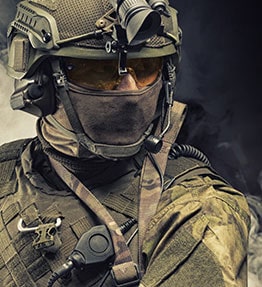Secure protection for today's sheriffs: a guide to body armor

For 48 of the 50 states, the county sheriff is a highly-valued, traditional figure of law enforcement. Depending on a sheriff's county, they may find themselves heading just one or two team members (such as in rural locations, which feature sparser populations), or they could operate in a busy department with a large roster of officers. A sheriff in an urban area such as Los Angeles or Chicago is likely to face more volatile situations than one based in a rural county, but there are no guarantees: each shift will bring its challenges, and a sheriff may never know what these may be.
When hostile armed suspects are a common threat, body armor is an essential part of the modern police officer's uniform. This is an unfortunate part of policing today's world, but thankfully there are now more options for protection than ever before. Today's sheriff can choose from a wide range of armor, offering protection against knives, handguns, and rifles, among other common weapons.
Ballistic Vests
Without a doubt, the most dangerous threat a sheriff is likely to face on duty is a suspect armed with a high-caliber weapon. Whatever the situation – a traffic stop gone wrong, a domestic incident spiraling out of control, or even a siege – the right ballistic vest can save lives. There are various types available, from vests designed to protect against 9mm handguns to automatic rifles. For greater simplicity, these are ranked in levels: II, IIIa, and IV.
As this ranking suggests, different vests offer varying protection against different rounds. Level II armor is designed to prevent injury from handguns, typically 9mm rounds, and are commonly worn by officers on street patrol. A sheriff may choose to wear a level II or IIIa vest for attending a domestic incident in a low-risk neighborhood, or patrolling streets on a busy evening. Level II and IIIa vests usually feature Kevlar as part of their design – one of the most commonly used materials for effective protection. Kelver can stop bullets before they can pass through the armor, however, severe bruising may still occur.
Level IV vests are designed for heavy-duty weaponry, such as sub-machine guns or rifles, and feature dense materials such as ceramics or Dyneema polyethylene. As a sheriff, wearing robust, reliable protection ensures you set a solid example for the rest of the team: be prepared for any situation.
Stab Protection
Knives are a perennial threat to law enforcement officers, and as with ballistics vests, edged blade armor (otherwise known as a stab vest) is categorized based on the level of protection it offers. There are two levels, level II and III. The latter level applies to vests designed to prevent injury from attacks made with a higher number of joules.
Spike Protection
Spiked weapons can also be used as improvised weapons by suspects, particularly in domestic situations or when they may feel under threat of arrest. A large needle, an ice pick, or a broken bottle may cause a severe injury when used with enough force, and can even be fatal – spiked armor vests can save lives by stopping the tip from passing through the threads in the material, as they would with normal clothing.
It's important to remember that one kind of body armor may not offer protection against all weapons. For example, if a sheriff wearing a stab vest is fired upon, the armor will not stop the bullet. The same applies if an officer wearing a ballistics vest is attacked with a sharp object, the armor would not stop the sharp object. You should consider which type of armor to wear before entering a situation that may pose a threat.
Should Armor be Covert or Overt?
There is no easy answer to this question. Wearing covert or overt armor is entirely down to you, depending on the area you are likely to patrol, and the situations you expect to face. An overt vest is worn over the uniform and is typically bulky. This may provoke a variety of reactions from civilians. Some neighborhoods, for example, may see a law enforcement representative in an obvious ballistic vest as an insult, or find it unnerving. On the other hand, it may alert potential criminals to the fact that a sheriff or sheriff's officer is in the vicinity, and prepared for trouble.
In other scenarios, covert vests may be more appropriate. These are worn beneath the uniform and discretely provide reliable protection. Covert vests are often favored by officers wearing civilian clothing, or working undercover – they offer peace of mind without highlighting the vest. Though they are thinner than overt vests, covert armors feature moisture-wicking fabrics, which keep you cool if wearing multiple layers.
Another option is the covert / overt vest, which offers versatility. This vest can be worn under or over your uniform, depending on the situation. These are manufactured to provide more protection than a standard covert vest, but are still thinner than most overt vests – this range of choice makes this armor a valuable product to keep close to hand at all times.
Choosing which type of armor is down to each individual. Depending on the types of people and situations you expect to encounter on an average shift, you should be able to assess the likelihood of specific risks beforehand.
Size and Fit: Key Considerations
This will come as no surprise if you've worn body armor before, but choosing the right fit for your body and needs is essential. Why? Because armor is designed to protect the body's vital organs, they should only cover the central part of the torso – they should hang no lower than the navel area. If a vest exceeds this part of the body, it could leave your range of motion inhibited, which could be fatal in a volatile situation.
Before purchasing body armor, you should measure yourself thoroughly to ensure the best fit and maximum protection. Never wear a vest that feels uncomfortable, be it too big or too small, as it could have fatal results.
When choosing armor, it's important to remember that you're investing in a product that may save your life someday. Don't skimp on cost, and never wear a damaged vest. A damaged vests effectiveness could be reduced and allow injuries to occur.
If in doubt, always seek expert advice.
 US
US UK
UK SE
SE NL
NL FR
FR ES
ES DE
DE







